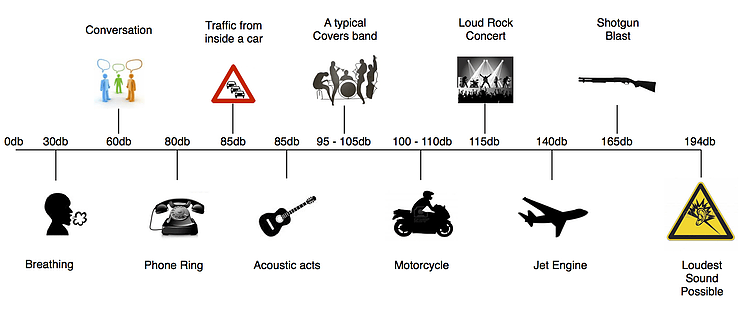What is a Sound Limiter?
If you’re looking to book entertainment for your event, it’s worth asking your venue if they have a sound limiter installed. A sound limiter is a device installed within certain venues to ensure that the noise level does not exceed a certain threshold. A microphone is fitted inside a unit and placed somewhere on the wall of the performance space, measuring the ‘loudness’ of any audio activity in decibels (dB).
If the audio volume exceeds a pre-defined ‘loudness’ (or dB level) for more than a few seconds, the unit will cut the electricity supply to the rest of the equipment plugged in to that electrical circuit.
In other words, power to guitar amplifiers, PA speakers and keyboards will be automatically switched off if the threshold is reached for a consistent period of time. In some cases, Sound Limiters need to be manually reset and in the best case scenario, it might take a minute or so for the electricity to come automatically back on again. This can cause unwelcome disruptions for both the guests and the musical act who are performing. It’s not unusual for a limiter to be activated 2-3 times in any 1-hour period. This means that the electricity supply will be cut off for anything between 10 and 15 minutes.
Why are sound limiters installed?
It is a legal requirement for some venues to have a sound limiter installed, based on their proximity to other public spaces and buildings. Sometimes it can be due repeated complaints from neighbours unhappy about the excessive noise levels late in to the night. Some old old venues will have them in place to prevent structural problems caused from rumbling bass. Occasionally sound limiters are installed in small venues to ensure the hearing safety of their guests.
Why can Sound Limiters be problematic?
Sound Limiters can sometimes cause a tricky situation – not just for the band, but the venue staff and even the client as well. A problem often faced by musicians is the huge difference between how limiters are set up between different venues. It’s possible to perform in one part of a room and not set the limiter off, but regularly trip the limiter if playing in a different location in the same room. Often, the threshold for sound limiters are set far too low for live music, and can be set off by something as little as clapping or a rowdy audience! Add live drums, bass and electric guitars into the mix and the threshold is going to be met very, very quickly. The acoustics of the room can also affect the way in which sound wave reflections are deflected towards the microphone, meaning that the positioning of the band is something else for your venue to consider.
For this reason, many bands now insist that the client takes responsibility for disruption to the performance caused by sound limiters fitted in a venue as it can be impossible to guarantee that the band will be able to play within the limiters threshold, despite their best intentions. If there is one key thing to remember, it’s that everyone is there for the same thing – to have a great time! Both the band and the venue are out to entertain the audience, and the audience is out to be entertained… so when dealing with limiters and volume restrictions, common ground can always be found!
Can’t the band just play quieter?
Something to remember when booking a band is that the un-amplified sound of the drum kit is what the rest of the band will set their equipment to. The un-amplified drum kit can’t be turned down, and tapping the drums softly to get a quieter sound doesn’t suit most music styles. Using ‘hot rods’ instead of drum sticks can reduce the volume a little, but has quite a different sound to what you’d expect from a drum kit. Another option is for the drummer to use an electric drum kit which can be played through the PA system, and therefore controlled in terms of volume. When using an acoustic drum kit (something most band do), it means that the drums set the president of volume of the rest of the band.
If the room has stone walls, the sound will reflect strongly and make the perceived loudness even louder. This is also the case with large sections of glass. If the room has a lot of acoustic absorption with lots of curtains and thick carpet, the same drummer will sound much quieter as much of the sound will be absorbed.
It’s important to understand that the ability of the band to ‘turn down’ or play subjectively quietly is very much determined by the room acoustics and how the sound bounces off or is absorbed by the various surfaces. If a sound limiter is fitted, it can sometimes be the case that the drum kit trips it out before the rest of the band even plugs in and in such cases there is very little that can be done to sort the problem other than increase the threshold of the sound limiter or switch it off.
Once the drummer has set up and starts to play, the band will set the volume of all other instruments to be heard over the top of the drums.
Remember…no band wants to play too loud for their audience or annoy the staff at the venue. They will always endeavour to play to your requirements but there are limits to how quiet any rock and pop band can play.
How will we know if the power is going to be cut?
Usually some sort of traffic light system is visible to help the artists or DJ to see when the music is approaching the limiters maximum permitted volume. Green is acceptable, orange is a warning that you are approaching the limit and then red – at this point, you might only have a couple of seconds before the limiter cuts the power to the mains! Power will usually be restored after around a minute or so, but some increase this blackout time if triggered more than once.
What sound level will create a problem if the venue has a Sound Limiter fitted?

Any venue with a sound limiter set lower than approx 90dB is definitely going to cause a problem for all but the quietest forms of music such as harp or classical guitar.
90dB – 95dB is problematic but in most instances would be ok for string quartets & jazz trios.
95dB is a very common setting and is likely to cause a problem for a lively rock and pop band. You’ll see from the comparison chart above that 95dB is equivalent to listening to music on an iPod or phone at 50% volume level, or listening up close to an un-amplified Oboe or Flute. As you can imagine, that’s not very loud! Many bands have performed within this limit, but have reported detrimental effects on their performance, with occasional or frequent tripping of the limiter.
95dB – 100dB will usually be workable with little detriment to the sound of the performance, although the band might need to use brushes rather than drum sticks, and you might find that the music seems a little ‘tame’ and uneenergetic.
Anything over 100dB should be fine as in our experience; most limiters are set between 92dB – 98dB. We believe the average volume level of most rock and pop function bands playing in a room with 150 capacity, with normal energy & enthusiasm is approx 110dB, with occasional volume peaks around 120dB.
Most styles of jazz or classical music will not suffer from the same problems as a rock and pop band because of the way the music is played and the equipment/instruments used.
We recommend that if live music is an important part of your evening, you book a venue without a sound limiter, or else check in advance what the venues policy is in case of interruption to the performance.
Alternatively, we have many acts who are more suitable to play within the constraints of sound limiter. If you are still concerned, please get in touch and we can discuss your requirements further.


